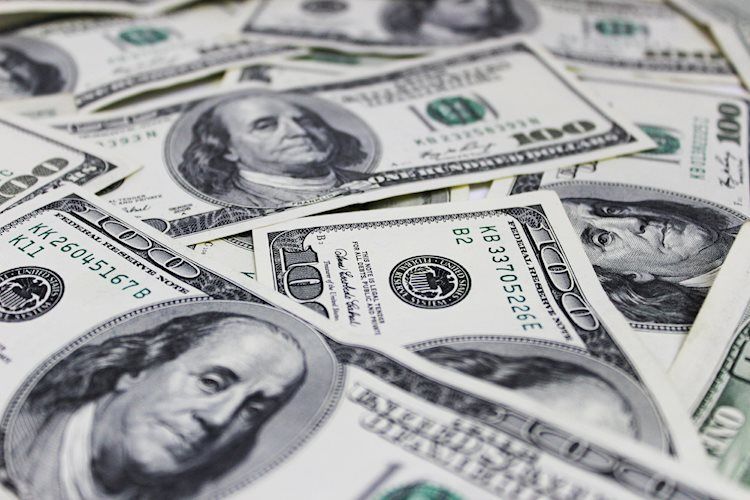- The DXY Index is bearing a slight uptick, lingering nearing three-month lows.
- US annualized Q3 GDP estimate was revised upward to 5.2%.
- The Fed’s Beige book report noted that economic activity slowed down up to mid-November.
- Markets await October Core PCE inflation on Thursday.
The US Dollar (USD) Index (DXY) is seeing modest growth, trading at 102.70 on Wednesday. The DXY found traction due to robust revisions in Gross Domestic Product (GDP) figures for Q3 arriving before Thursday’s Personal Consumption Expenditures (PCE) inflation data for October. The Greenback is also getting interest on the back of hawkish words from Federal Reserve’s (Fed) Thomas Barkin, who did not rule out another hike this cycle.
Despite the mixed labour market and cooling inflation, Fed officials aren’t excluding the possibility of further policy tightening, thereby adopting a slightly hawkish stance. This seems to be an attempt to prevent any potential inflation slips and reflects the delicate balance the central bank is trying to maintain. That being said, it will come down to the incoming data, and Thursday’s PCE figures from October will have an impact on expectations for coming Fed decisions.
Daily Market Movers: US Dollar rises on strong GDP revisions and hawkish words from Thomas Barkin
- Amid optimism of a soft landing, the US Dollar trades with mild gains today. The driving factors are the revised Q3 GDP data.
- The GDP was revised to 5.2%, surpassing the consensus estimate of 5% and the previous estimate of 4.9%.
- The Federal Reserve’s Beige book, which gives insights on the US economic activity, reported that up to mid-November, the US economy slowed down while the labor demand and inflationary pressures eased.
- Elsewhere, Thomas Barkin from the Fed stated that he is not confident that inflation is on track to reach the bank’s 2% target, and he didn’t rule out another rate hike.
- Meanwhile, US Treasury yields are currently dipping but trimmed some of the daily declines. The 2-year, 5-year and 10-year yields stand at 4.65%, 4.21% and 4.27%, respectively.
- Markets await Thursday’s Core PCE figures from October, the Fed’s preferred inflation gauge, which is expected to have decelerated to 3.5% YoY from 3.7% in September.
- Meanwhile, the CME FedWatch Tool suggests that the Fed won’t hike in the December meeting, and the markets are foreseeing rate cuts beginning in May 2024.
Technical Analysis: US Dollar under bearish pressure, RSI in oversold territory
Indicators on the daily chart are painting a bearish picture for the US Dollar. The Relative Strength Index (RSI) position suggests an overwhelming selling momentum standing flat at 30. Concurrently, the Moving Average Convergence Divergence (MACD) histogram displays a descending trajectory indicative of ongoing bearishness. The bear control is further affirmed by the currency’s position in relation to the Simple Moving Averages (SMAs).
On a broader scale, the asset is trading beneath the 20, 100 and 200-day SMAs, underlining the prevailing strength of the bears. In this challenging scenario, buying momentum is noticeably struggling. These technical signals derived from the RSI, MACD and SMAs collectively point toward continued bearish dominance for the US Dollar in the immediate term.
Support levels: 102.50, 102.30, 102.00.
Resistance levels: 103.60 (200-day SMA), 104.00, 104.20 (100-day SMA)
GDP FAQs
A country’s Gross Domestic Product (GDP) measures the rate of growth of its economy over a given period of time, usually a quarter. The most reliable figures are those that compare GDP to the previous quarter e.g Q2 of 2023 vs Q1 of 2023, or to the same period in the previous year, e.g Q2 of 2023 vs Q2 of 2022.
Annualized quarterly GDP figures extrapolate the growth rate of the quarter as if it were constant for the rest of the year. These can be misleading, however, if temporary shocks impact growth in one quarter but are unlikely to last all year – such as happened in the first quarter of 2020 at the outbreak of the covid pandemic, when growth plummeted.
A higher GDP result is generally positive for a nation’s currency as it reflects a growing economy, which is more likely to produce goods and services that can be exported, as well as attracting higher foreign investment. By the same token, when GDP falls it is usually negative for the currency.
When an economy grows people tend to spend more, which leads to inflation. The country’s central bank then has to put up interest rates to combat the inflation with the side effect of attracting more capital inflows from global investors, thus helping the local currency appreciate.
When an economy grows and GDP is rising, people tend to spend more which leads to inflation. The country’s central bank then has to put up interest rates to combat the inflation. Higher interest rates are negative for Gold because they increase the opportunity-cost of holding Gold versus placing the money in a cash deposit account. Therefore, a higher GDP growth rate is usually a bearish factor for Gold price.

